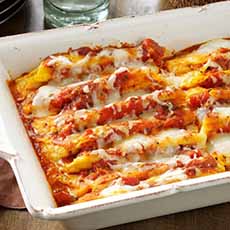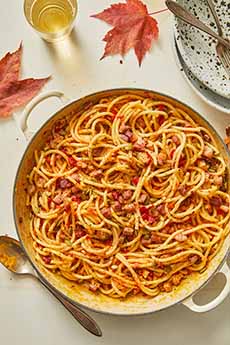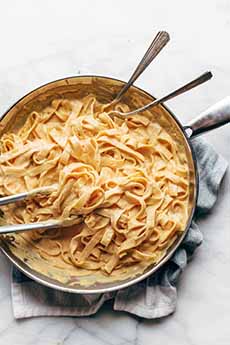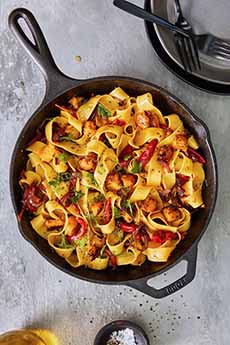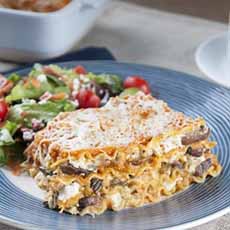Pumpkin Manicotti Recipe For Fall, Halloween & Thanksgiving
|
|
October is National Pasta Month and National Pumpkin Month. National Pasta Day is October 17th; October 25th is World Pasta Day. October 26th is National Pumpkin Day. Because of the holidays…the harvest season… Halloween…and Thanksgiving, we thought we’d combine Old World pasta with New World pumpkin. Hence: Pumpkin Manicotti, a Taste Of Home contest winner. The recipe was created by Mandy Howison of Renfrew, Pennsylvania, who makes ravioli and tortellini using the same filling, and notes that it also works well in stuffed shells. In addition to Pumpkin Manicotti, there are more pumpkin pasta recipes below. You’ll also find the below the history of manicotti. Manicotti is the American term for what Italians call cannelloni. Prep time is 30 minutes, and bake time is 25 minutes. For more sophisticated flavors, check out this Pumpkin & Goat Cheese Cannelloni (a.k.a. Manicotti) With Sage, from The Pasta Project. 1. PREHEAT the oven to 350°F. Cook the manicotti shells according to package directions for al dente. Drain. 2. MIX the ricotta cheese, 1 cup of mozzarella, the pumpkin, Parmesan cheese, egg yolks, and nutmeg in a large bowl. Spoon into the manicotti shells. 3. SPREAD 1 cup of pasta sauce into a greased 13 x 9-inch baking dish. Top with the stuffed manicotti. Pour the remaining pasta sauce over the top; sprinkle with remaining mozzarella cheese. 4. BAKE, covered, for 25-30 minutes or until the cheese has melted. 5. SPRINKLE with optional herbs and serve with Parmesan cheese, if desired. We put a wedge of Parmesan on a plate with a grater and pass it around the table. Did you know that manicotti is the same pasta shape as cannelloni*? In Italy, this pasta tube is called cannelloni. In the U.S., it’s called manicotti or maniche (mah-NEE-kay), meaning sleeves. Both of these names refer to either dried pasta tubes or fresh pasta sheets rolled into tubes. Both are stuffed and then baked. According to Wikipedia, the original difference may be that cannelloni consists of pasta sheets wrapped around the filling, and manicotti are machine-extruded cylinders with the filling inserted from one end. Cannelloni is not an ancient shape. According to some food historians, the first stuffed pasta tube—call it the cannelloni prototype—dates to the first half of the 19th century. Reportedly, Vincenzo Corrado, a Neapolitan cook, made a stuffed version of paccheri*. Paccheri are very large, but short, tubes of pasta, originating in the Campania region of Italy—on the western coast right above the “boot.” Corrado filled paccheri tubes with minced meat and truffles and cooked them in a tomato sauce. It was an unusual way to serve paccheri at that time. The tubes were typically cooked plain and covered with sauce (and still are). But did paccheri become canneloni? Did cannelloni develop independently? According to another version of the origin story, the latter may be true. It credits the invention of a dish called cannelloni to a hotel chef on the Amalfi coast (also in the Campania region of Italy), in 1924. It is believed that the chef, Salvatore Coletta, cut up sheets of fresh lasagne noodles, topped them with filling, and rolled them into tubes. His original filling contained minced meat, béchamel sauce, ricotta, Parmesan, and fior di latte mozzarella. He then covered the rolls with tomato sauce and them. You can read that story here. Of course, it’s easily possible that two creative chefs could have come up with a similar thought: tubes just begging to be stuffed, lasagna noodles waiting to be repurposed, rolled around a filling, instead of being baked flat, instead topped with layers of fillings. Both paccheri and cannelloni/manicotti can be smooth or ridged. Both are considered hearty pasta for robust and flavorful sauces. Cannelloni and manicotti can be made with many different fillings: cheese, meat, seafood, vegetables, even tofu and other vegan fillings. Similarly, the sauces can be meat-based, like a traditional bolognese; dairy-based, like a classic béchamel; and or vegetable-based, with butter or olive oil. For seafood manicotti, you can use an oil-based sauce with clams, shrimp, mussels, etc; or make a luxurious béchamel with diced lobster or shrimp. ________________ *Cannelloni derives from the Latin word for reeds. This evolved into the Italian word cannello, tube. Manicotti means “big sleeve” in Italian. †Paccharia, which translates to “slaps,” is said to refer to the slapping sound made when the sauce was poured onto the pasta. |
|
|
|
||
